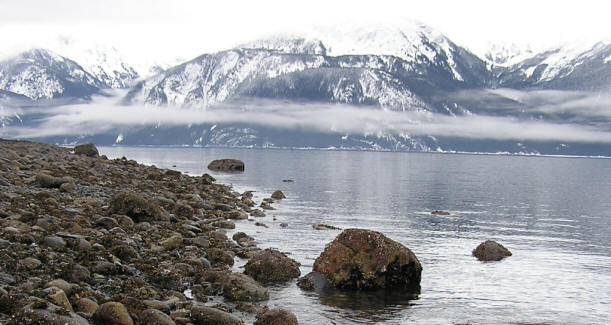by John Eller
We need supplies enough to sustain two people for three weeks at sea on an eighteen-foot commercial fishing boat. AC VALUE CENTER: Food and Liquor, in Cordova, Alaska serves the far edges of The Last Frontier state. The industrial supermarket’s minimal lighting shines on unreflective concrete floors. Commercial-sized boxes of cereal and instant noodles fill the matte shelves. A collection of cardboard boxes is piled behind the idle cashiers. The store brings to mind a trading depot in remote outposts during the Gold Rush, but with modernized foodstuffs instead of salted moose meat on hooks and rough-hewn drums of flour and sugar.
Brian and I originally bonded at a gym in Texas where we spent six months bemoaning our romantic foibles and the cost of East Coast schools—I wanted to study writing, he had applied to MIT. We were two skinny kids who could never seem to beef up, regardless of how many pounds we loaded onto the bench-press. Our vegetarian diets probably had something to do with this. Then, suddenly, Brian left for Alaska, my home state, to fish. He said he wouldn’t return until he’d saved enough to build his own music recording studio and buy a house. After two years of working halibut longlines in the spring, salmon seiners in the summer, and diving for sea cucumbers in the fall and winter, he was still broke. Worse: he was in debt. He called to offer me a job. I agreed to be a deckhand because he promised a minimum of five thousand dollars, regardless of how the season turned out. I figured this would be a nice pillow to ease my impending move to New York City.
“Let’s get ‘er done.” Brian grabs an oversized cart and leads us into the produce section of AC VALUE. “Remember, food is my dime, so go bananas.” His broad shoulders and paunch make me wonder what he’s been eating. Clearly, it takes more than tofu tacos to power the salmon industry. I knew this when I signed up, but I still want my leafy greens.
Alaskans rely on pricey California produce most of the year, vegetables grown with surgical precision yet aged by the long trek up the ALCAN Highway. I can see the three-thousand-mile journey in waxed yet pallid Red Delicious Apples sold for three dollars apiece. The nectarines look like old peaches. The broccoli crowns shipped in refrigerated semis to Anchorage, then barged in to Cordova, are yellowish, and five bucks a bunch.
Brian loads Yukon Gold potatoes, yellow onions, and green bananas—staples—into the cart. Space is limited so I defer to the captain.
“How about cherry tomatoes?” I ask, holding up a quart.
“Meh, we’ll buy a few cases of V8.”
The poor-looking, expensive produce is nothing like the Matanuska Valley vegetables I saw at the Alaska State Fair as a kid: cabbages that weighed as much as I did; a fifteen-hundred-pound pumpkin that I wanted to carve into a Jack O Lantern fort; or rutabaga and zucchinis bigger than watermelons. The long days and combination of volcanic and glacial sediment contribute to these record-breaking show-veggies. But the midnight sun lasts only a few months, and as the winter solstice looms it’s impossible to grow a single clover, let alone forty-pound kale plants.
I sneak a bag of Brussels sprouts into the cart before we move away from produce.
We file through wide aisles, loading cases of ramen, peanut butter, and cereal. Brian grabs dozens of Chef Boyardee cans: Overstuffed Beef Stromboli, Mini Dinosaurs with Meat Balls, Beefaroni (with whole wheat pasta), Cheesy Nacho Rotini.
“Hey buddy, I’m a pescatarian,” I say.
“Tuna’s down on the right.”
“But we can eat salmon, right?”
“Yeah, technically, we can. But we probably won’t. Takes too much time.”
“I like cooking.”
“And I like quantum mechanics.” The former science geek is dead earnest. “But we came here to kill salmon, not play Julia Child on a pirate ship. Get a lot of tuna.” Brian’s principle aim in food shopping seems to be to fit in as many calories per cubic inch as possible. Is this how all people in remote, industrial regions think about food? The North Slope oilfield workers I’ve met over the years embody a similar approach: food is good and all but mostly it’s just fuel.
We top the cart off with canned green beans and refried beans, peaches, pears and pineapple in thick syrup, spray cheese, an eight-pound sack of pistachios and forty single-serving bags of Chocolate Lover’s trail mix, lots of Baby Wipes and hand sanitizer, two gallons of Folgers, two cases of single-serving instant oatmeal, and a fifth of whiskey to sip before sleep on rough seas.
As I load the groceries onto the conveyor belt, I wonder if I’ll finally grow thicker, like Brian. We file out of AC VALUE with boxes of food, our fuel.
John Emrys Eller is a student, writer, chef and builder. He eats words like this for breakfast.


Comments are closed.